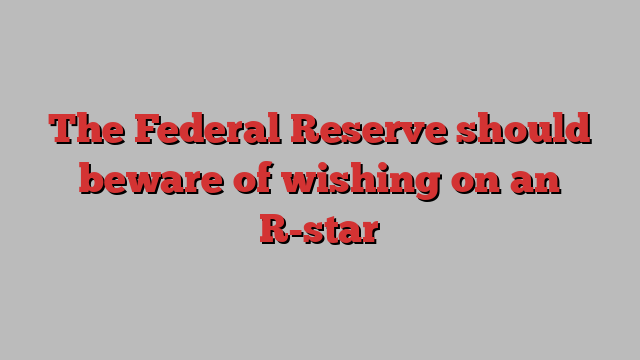
Unlock the Editor’s Digest for free
Roula Khalaf, Editor of the FT, selects her favourite stories in this weekly newsletter.
The writer is president and chief investment strategist at Yardeni Research
From early March 2022 through August 2024, Federal Reserve officials aimed to tighten monetary policy sufficiently to bring inflation down even though it was widely expected to cause a recession. They succeeded in doing so without a recession.
Now inflation is closing in on their 2.0 per cent target, they are aiming to keep the unemployment rate from rising. They intend to do so by lowering the federal funds rate to its “neutral” level, at which inflation remains subdued while unemployment remains low. This nirvana level is often called R-star (or R*) by economists.
The problem is that the economy very nearly achieved that state before the policy-setting Federal Open Market Committee cut the federal funds rate by half a percentage point on September 18 to 4.75 to 5.00 per cent. The FOMC also signalled more easing ahead in its quarterly Summary of Economic Projections of committee members. This showed that the median forecast of participants for the “long run” neutral federal funds rate was 2.90 per cent. They collectively deemed this would be consistent in the long run with the unemployment rate at 4.2 per cent and an inflation rate of 2.0 per cent. This implies that the real neutral federal funds rate is 0.90 percentage points, well below the current level.
Of course, the concept of a neutral federal funds rate is a totally theoretical concept. Everyone agrees that it cannot be measured and will vary over time depending on numerous economic factors. Even the committee’s estimates for this long-run rate varied from 2.37 to 3.75 per cent.
The concept of a real neutral federal funds rate is just as unfathomable, if not more so. It is extremely doubtful that anyone bases their economic decisions on an overnight bank lending rate that is adjusted for inflation measured on a year-over-year basis.
Fed officials were undoubtedly alarmed by the apparent weakness in the labour market shown by data released just before their September FOMC meeting. But after the meeting, it was reported that September’s employment gains were stronger than expected and that July and August payrolls were revised higher. Furthermore, the unemployment rate fell back to 4.1 per cent.
Meanwhile, the “supercore” inflation rate (core services excluding housing) remained stuck well above 2.0 per cent in September. In late 2022, Fed chair Jay Powell said this rate “may be the most important category for understanding the future evolution of core inflation”.
So why are several Fed officials saying that they are still committed to additional rate cuts? Apparently, they believe that since inflation has declined significantly since the summer of 2022, they must lower the nominal federal funds rate to keep the real rate from rising and becoming too restrictive. They want it to go down towards their estimate of the real R-star. They fear that if the real rate is allowed to rise, inflation will fall below 2.0 per cent and unemployment might soar. So they are wishing upon an R-star that is a known unknown.
The bond market’s reaction to the Fed’s supersized rate cut on September 18 is telling — a strong rise in the 10-year US Treasury yield and the increased inflation premium priced into that as measured by comparison with Treasury inflation-protected securities.
That raises yet another question about the relevance of inflation-adjusted R-star. Fed officials intend to lower the federal funds rate because actual inflation has moderated. But their initial move to do so seems to be boosting expected inflation in the bond market. Most economists seem to agree that, in theory, R-star should be adjusted for expected rather than actual inflation.
Fed officials seem to have committed to a series of rate cuts to get the federal funds rate down to neutral, wherever that might be. That seems awfully naive given that the next FOMC meeting will occur just after the US presidential elections. The outcome could have a significant impact on R-star. Both presidential candidates favour policies that are likely to widen the federal deficit and have inflationary consequences.
Fiscal policy must have some impact on R-star. Yet, Fed officials are acting as though only monetary policy matters. Wishing upon R-star will not fix what is wrong with fiscal policy. Large federal deficits over the past few years helped to explain why the economy did not fall into a recession when the Fed tightened monetary policy. Yet inflation subsided. What if, as a result, nominal and real R-star are much higher than Fed officials believe? If the Fed keeps lowering the federal funds rate, it risks reviving inflation. The message from the bond market is beware of what you wish for when wishing upon an R-star.